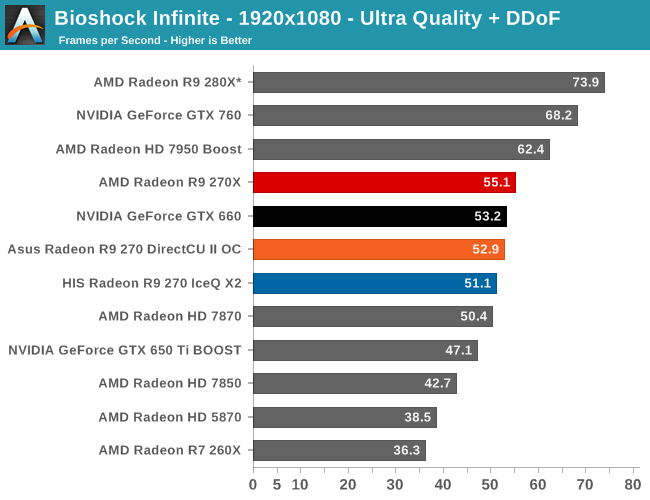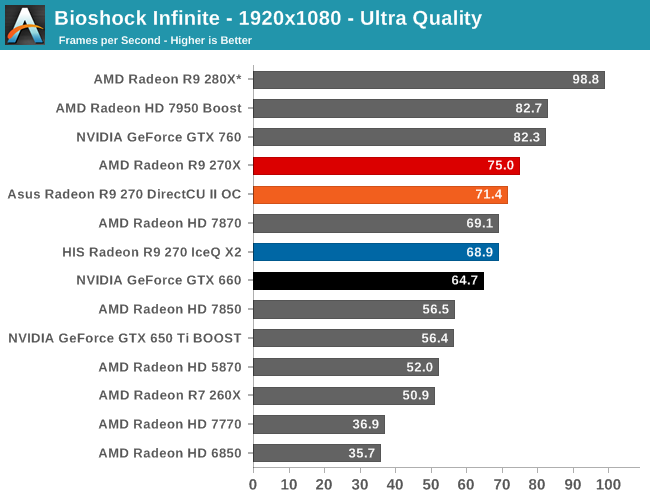The AMD Radeon R9 270X & R9 270 Review: Feat. Asus & HIS
by Ryan Smith on November 13, 2013 12:01 AM ESTBioshock Infinite
Bioshock Infinite is Irrational Games’ latest entry in the Bioshock franchise. Though it’s based on Unreal Engine 3 – making it our obligatory UE3 game – Irrational had added a number of effects that make the game rather GPU-intensive on its highest settings. As an added bonus it includes a built-in benchmark composed of several scenes, a rarity for UE3 engine games, so we can easily get a good representation of what Bioshock’s performance is like.


Bioshock tends to be a close matchup between similar AMD and NVIDIA cards, and this review is no exception. The 270X holds a small but distinct lead over the GTX 660, but the 270 vanilla trails the GeForce card by roughly the same amount. With the 270 and GTX 660 priced equivalently, this is essentially a slight loss for the 270.
On a side note, taking a moment to stop and look at the 270 in the frame of reference as a 150W card, we can see just how much AMD has improved their performance within the 150W envelope. Compared to their outgoing 7850, their last 150W card, the 270 is 20% faster. As we’ll see in a bit, real world power usage will be higher – there isn’t a free lunch on the same node – but for systems constrained by a 150W limit this is a clear improvement over previous options.










59 Comments
View All Comments
Waveblade - Wednesday, November 13, 2013 - link
It's like different people work on different products!Roland00Address - Wednesday, November 13, 2013 - link
A commandment of any cell phone reviews, thou shall not rush battery life tests.Tetracycloide - Wednesday, November 13, 2013 - link
Be thou particularly careful testing battery life when thine available anecdotes vary wildly. Be thou definitive.slayerxj - Wednesday, November 13, 2013 - link
I may not read the article very carefully, and I keep wondering that why 280X has a star behind it.Gigaplex - Wednesday, November 13, 2013 - link
I'm getting a little tired of this TDP nonsense. Two cards with the same TDP from the same product family of the same manufacturer that clearly consume different amounts of power - the TDP numbers are now meaningless. And don't get me started on Intels SDP.yannigr - Wednesday, November 13, 2013 - link
If both are under 150W, then where is the problem? Maybe R9 270 consumes close to 130W-140W and not 150W, giving the necessary room to AMD's partners to oc the chip without passing the 150W limit.dylan522p - Wednesday, November 13, 2013 - link
OCed 270 is 270xslapdashbr - Monday, November 18, 2013 - link
Under 150W means it only needs one 6-pin power connector (like the 7850 or 660 which it replaces/competes with) and in general is much more power-efficient. The 270 (non-x) is aimed more at builders with power limits or old systems that can't support a dual-6-pin GPU, or perhaps computational tasks where performance per watt is more important than performance per card. The 270x is full-powered but less efficient and is better suited for gamers and tweakers. I wouldn't get a 270 to save $20 unless the lower power limit was important, in which case it's actually a good buy, as it should still edge out a gtx 660 while staying under 150W total power.dylan522p - Wednesday, November 13, 2013 - link
SDP at least makes sense.maximumGPU - Wednesday, November 13, 2013 - link
quick comment on the DCUII coolers from asus. I too have been very impressed with them. my goal was silent yet powerful computing, and the DCUII cooler on my GTX670 plays that part admirably.